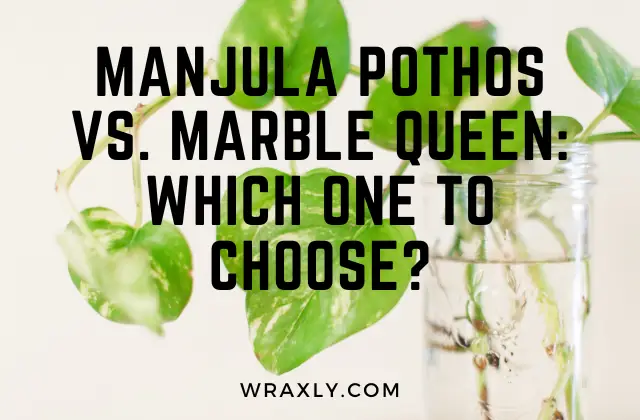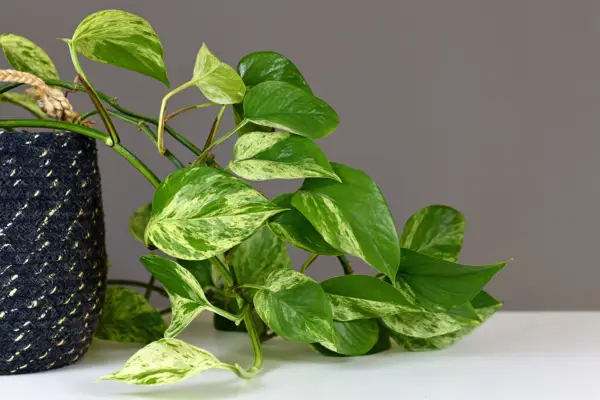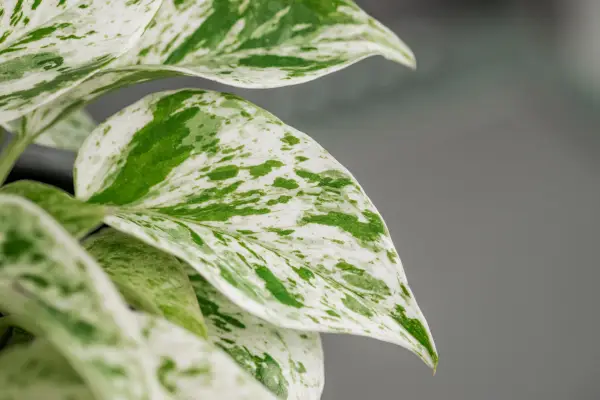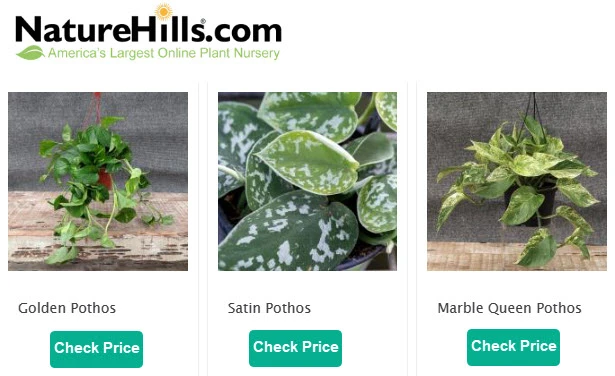Dreaming of bringing a burst of vibrant greenery into your indoor space? Or maybe you’re itching to add a touch of nature’s wonder to your home’s ambiance? Look no further than the delightful Manjula Pothos and the charming Marble Queen! These two plants are like the life of the indoor plant party, with their cascading vines and foliage that simply steal hearts.
But hold on a sec, are they just two peas in a pod? Well, not exactly! Despite their similar looks, they’re actually quite distinct. And guess what? There’s an ongoing friendly debate about whether it’s Team Manjula Pothos or Team Marble Queen that takes the crown.
Are you caught up in the same delightful dilemma? Fear not! We’re about to take a delightful journey into the worlds of these green darlings. By the time we’re done, you’ll be armed with all the info you need to decide whether you’re Team Manjula or Team Marble Queen! So, let’s dive in and uncover the secrets of these lovely plants.

What Is Manjula Pothos?
Manjula Pothos, also widely known as Epipremnum aureum Manjula, is one of the rare and splendid cultivars of the classic Pothos family that is hard not to fall in love with.
From having heart-shaped leaves to a mesmerizing blend of creamy white, minty green, and silvery hues – this evergreen perennial plant looks like a living waterfall.

Plus, they are super easy to care for as well. In fact, they are one of the most reliable partners in greenery that will certainly make your job much simpler and hassle-free when it comes to maintenance.
They thrive best in medium to low light conditions. Find a snug corner with indirect sunlight, and you’re all set for success!
If the top inch feels dry, it’s time to water. Ensure that water penetrates the soil evenly and reaches the root zone. However, avoid letting your plant sit in excess water, as this could lead to root rot. Remember, it’s better to water deeply and less frequently than to give shallow, frequent waterings.
What Is Marble Queen?
True to its name, the Marble Queen plant isn’t your run-of-the-mill member of the plant kingdom. It’s more like the diva among indoor plants, effortlessly infusing your space with a touch of unmatched elegance from the instant you welcome it.

And you know what’s even better? These plants aren’t all about looks – they’re incredibly low-maintenance too. Whether you’re a new plant parent or a seasoned gardener, taking care of them is a breeze. It’s a class act that anyone can master.
Simply place them in a well-lit spot where they can enjoy a touch of direct sunlight, and only give them a drink when the soil feels slightly dry. That’s all there is to it!
When it comes to air purification, the Marble Queen plant is a true champion. It has the power to transform your space into a pristine oasis, where every breath you take feels refreshingly divine!
It’s important to highlight a crucial point – these plants can be toxic and should not be ingested by pets. If you have furry friends, be sure to keep the plants out of their reach. Additionally, for individuals with plant allergies, it’s advisable to steer clear of them as well. Your well-being, along with your pets’, is the priority!

Comparison Table of Manjula Pothos Vs. Marble Queen
Now that you’ve got a grasp on the essentials of Manjula Pothos and Marble Queen, let’s take a look at a side-by-side comparison:
| Manjula Pothos | Marble Queen | |
| Origin | Native to Southeast Asia, French Polynesia, and Australia | University of Florida |
| Botanical Name | Epipremnum aureum ‘HANSOTI14’ | Epipremnum aureum‘Marble Queen |
| Common Name | Manjula Pothos | Marble Queen Pothos |
| Family | Araceae | Araceae |
| Growth Rate | Slow | Fast |
| Leaves | Comes with a shade of silver, white, cream, and light green shades, which can be seen in the variegation of the foliage. | They have heart-shaped leaves, with several creamy white streaks and splashes. |
| Color of Leaves | Splash of green, white, and cream | A swirl of white, light yellow, and cream |
| Mature Size (Indoors) | 6 feet long and 3 feet wide | 10 feet long and 3 feet wide. |
| Light | Indirect Sunlight | Direct Sunlight |
| Leaf Shape | Broad and Flat | Wavy and Frilly |
Manjula Pothos Vs. Marble Queen: Explained!
From their elegantly trailing vines to their distinct patterns, these two beauties have a plethora of differences waiting to be revealed. Here they are:
Taxonomy Classification
Both Manjula Pothos and marble plants hail from the same family Araceae, genus Epipremnum, and species Epipremnum aureum.
However, what differentiates them from each other on a scientific basis is they have multiple varieties. That is, both of these plants are different varieties of pothos, with the botanical name Epipremnum aureum “Manjula” and Epipremnum aureum “Marble Queen” respectively.
So, the moral of the story is they are cousins belonging to the same plant family but have their own unique characteristics.
Leaf Shape and Texture
Manjula Pothos comes with heart-shaped leaves along with graceful splashes of creamy white and green shade, offering a sophisticated vibe. Their leaves are more kind of frilly and wavy.
On the other hand, the leaves of the Marble Queen grow straight and are super smooth to the touch compared to the Marjula Pothos. And upon touching them, you will feel a certain kind of waxy and glossy texture, much like the cucumber.

Color and Patterning
Next up, we have color and patterning. Believe it or not, this is the easiest way to tell them apart.
Though both of them come with cream and white spatters, if you closely observe them, you will find quite a difference.
Take, for instance, the leaves of the Manjula Pothos. They showcase a delightful interplay of creamy white splashes intertwined with gentle hints of light yellow. This charming pattern originates from the heart of each leaf and gracefully extends outward to its edges.
However, don’t be surprised if you also encounter a touch of deep green along the leaf’s borders. This pattern variation tends to appear sporadically and can greatly differ from plant to plant, influenced by factors like leaf size and spread.
In contrast, the leaves of the Marble Queen sport a softer and elongated coloring, primarily showcasing a steadfast blend of white and cream. This coloration envelops a larger portion of each leaf’s surface, spreading in a more uniform manner outward from the central vein, setting it apart from the Manjula Pothos.
In simpler terms, the leaves of the Marble Queen appear as if they’ve been gently immersed in paint over an extended period, resulting in the unique and captivating coloration they exhibit.
Distribution and Origin
Moving on, we have their distribution and origin. Manjula Pothos are found growing in large numbers in places like Southeast Asia, Australia, France, and Polynesia.
On the flip side, the Marble Queen is a crossbreed variety that has been meticulously cultivated by the University of Florida. Unlike their natural counterparts, these plants are entirely man-made, a result of intentional breeding.
The dedicated botanists at the university had a clear objective: to craft this exquisite beauty with the vision of enhancing its resilience to diverse weather conditions, setting it apart from other pothos varieties.
Manjula Pothos vs Marble Queen Growth Habit
The growth rate of the Manjula Pothos is pretty moderate when grown indoors. They can reach up to a length of 6 to 10 feet (1.8 to 3 meters). Plus, they have a more compact growth than the Marble Queen. This makes them a good pick for small areas or hanging baskets.
Now for the Marble Queen, they have quite a fast growth rate, with the vines being able to grow as long as 10 to 20 feet (3 to 6 meters).
They are a perfect option for hanging baskets or climbing plants if given the support of a trellis or moss pole.
Why Choose Manjula Pothos?
To start, they’re like the superstars of low-maintenance plants. So, if you’re a busy plant parent with a packed schedule, this plant is your perfect match. It’s like having a friend who remains cool even if you occasionally forget to treat them or remember their birthdays!
If you’re concerned about the air quality, fear not! The Manjula Pothos can play the role of your very own air purifier. Not only does it excel at eliminating various toxins, but it also excels at infusing the space with rejuvenating, fresh air. Its magic works in perfect silence, transforming your environment without a sound!

Why Choose Marble Queen?
Whether it’s adorning hanging baskets, gracing a shelf, or elegantly cascading down a trellis, the Marble Queen stands out as one of the most versatile plants you’ll ever encounter. Its adaptability knows no bounds!
And here’s the best part: they’re remarkably forgiving when it comes to watering. Even if you happen to forget a watering session, these plants will still stand tall and radiant, unaffected. A sigh of relief for the forgetful plant parents or those who are always on the go.
Much like the Marjula pothos, they are also powerful air-purifying plants that can actively clean the toxins or any other impurities from the air. Ultimately turning your living area into a true sanctuary.
Manjula Pothos vs Marble Queen – What To Be Aware Of?
Without any doubt, these two charismatic houseplants are the stars of indoor gardening, but like any other A-list star, they also have a few things that you must be aware of:
- While they certainly fall into the low-maintenance category, they hold a particular fondness for bright yet indirect sunlight. The cozier the spot you can provide, the more they’ll radiate their vibrant best.
- When it comes to watering, embrace the Goldilocks principle – not too much, not too little, but just right. Wondering how to gauge this balance? Insert your finger into the soil about an inch deep. If it’s dry to the touch, it’s time for hydration. On the other hand, if it feels slightly moist, hold off on watering for the moment.
- Marjula Pothos is the daring adventurer, forever eager to discover new spaces. Offer them a tiny trellis or a touch of support, and watch as they proudly display their remarkable climbing skills. On the other hand, the Marble Queen prefers a grounded domain, a place where they can unfold their elegance horizontally, creating a captivating expanse of beauty.
- Another crucial aspect to keep an eye on is the presence of yellow or damaged leaves. Should you come across any, don’t hesitate to swiftly remove them. This proactive step will contribute to fresher, more vibrant growth and overall plant health.
Manjula Pothos vs Marble Queen FAQs
The main difference between Marble Queen and Manjula Pothos lies mainly in their leaf design. For instance, the leaves of Manjula Pothos are somewhat frilly and wavy, whereas the Marble Queens have smoother edges and consistent marble-like variegations.
Yes, compared to other varieties of pothos, they are a pretty rare gem. Their exquisite coloration and limited availability are what make them a rare species and a sought-after plant among admirers.
This condition is quite unlikely as this mutation is completely genetic. However, you can still propagate the healthy parts to grow into a new variegated plant.
Should your Manjula Pothos find itself basking in excessive direct sunlight or lacking the essential nutrients, it’s likely to develop a paler hue. To prevent this, ensure you position them in an appropriate spot and supply the necessary fertilizers. Unless, of course, you’re aiming for a whiter appearance!
Yes. Manjula Pothos showcases a more compact growth pattern, characterized by its distinct and irregular variegation. Meanwhile, the Marble Queen boasts a more consistent, marble-like variegation that spans its leaves uniformly. Notably, the Marble Queen’s growth can be surprisingly rapid, resulting in impressively long vines in a relatively short period.
Final Thoughts on Manjula Pothos vs Marble Queen
In the captivating world of indoor plants, the choice between Manjula Pothos and Marble Queen comes down to the nuances that define their unique personalities. From their distinct variegation patterns to their growth habits and care requirements, each plant brings its own charm to your green oasis. Whether you’re drawn to the adventurous spirit of the Manjula Pothos or the elegant allure of the Marble Queen, both offer the opportunity to create a harmonious and thriving indoor space.
Armed with a deeper understanding of their differences, you’re now equipped to make a choice that resonates with your gardening aspirations. Whichever path you choose, may your journey into the realm of these botanical wonders be filled with growth, beauty, and the joy of nurturing nature within your home.

Darrell has a passion for gardening that he inherited from his father. Go here to read more about the influence his father played in his love for gardening. If you want to send Darrell a quick message, then visit his contact page here.

![How to Water Indoor Plants [Plant Care 101]](https://wraxly.com/wp-content/uploads/2021/03/How-to-Water-Indoor-Plants-Plant-Care-101-1200-1024x576.webp)

![Growing Plants from Cuttings [A Simple Guide]](https://wraxly.com/wp-content/uploads/2021/03/Growing-Plants-from-Cuttings-A-Simple-Guide-1200-1024x576.webp)